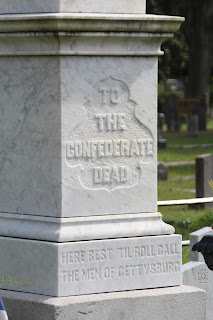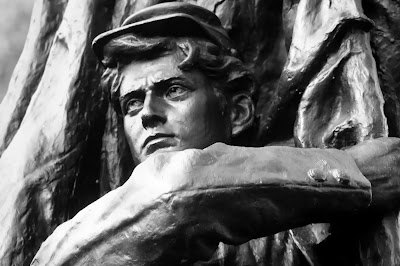The 48th Georgia at Gettysburg
They were three days which changed the world. So much of the courses of our lives today were set in motion in the rolling hills of southern Pennsylvania exactly 150 years ago today. The place, Gettysburg, Pennsylvania - a cross roads town just above the Maryland border - would become the scene of the most horrific carnage of the Civil War or any other war on American soil. Nearly 50,000 men, roughly thirty percent of the effectives on the field of battle. were killed, captured, wounded or missing in action in three dying days.
Each corner of the battlefield has its own name. Little Round Top, The Devil's Den, The Peach Orchard, The Wheatfield, and Cemetery Ridge are names which still live in infamy. Every year, more than a million people conduct pilgrimages to the scene of the climactic battle of the Civil War.
Robert E. Lee, still celebrating his greatest victory at Chancellorsville, launched his first invasion of Pennsylvania. Although Lee wanted to avoid contact with the Union army at Gettysburg, advance elements of both armies collided on July 1, 1863, sucking both combatants into the chasm of the war's most brutal and critical battle.
 On the second day of the battle, Robert E. Lee launched an all out attack on the Federal positions from Little Round Top to Cemetery Ridge. Each division attacked in order from south to north. Late in the afternoon, the order came for A.R. Wright's brigade to attack the Federal positions on Cemetery Ridge. The brigade commander (LEFT) was a Louisville born attorney, whose brigade consisted of four Georgia Regiments, including the 48th Georgia.
On the second day of the battle, Robert E. Lee launched an all out attack on the Federal positions from Little Round Top to Cemetery Ridge. Each division attacked in order from south to north. Late in the afternoon, the order came for A.R. Wright's brigade to attack the Federal positions on Cemetery Ridge. The brigade commander (LEFT) was a Louisville born attorney, whose brigade consisted of four Georgia Regiments, including the 48th Georgia.
The 48th Georgia was composed of companies from Jefferson Co., "The Jefferson Volunteers"; Johnson Co., "The Battleground Guards; Twiggs Co., "The Slappey Guards"; and Emanuel Co., "The McLeod Volunteers." Several Laurens County residents were members of the Battleground Guards. The 48th Georgia were a part of R.H. Anderson's Division of A.P. Hill's Corps.
At 6:30, Anderson sent his three remaining brigades to attack the center of Cemetery Ridge. Wright's men were deployed from left to right: 48th Georgia, 3rd Georgia, and 22nd Georgia. The 2nd Georgia was deployed in front as skirmishers. A few hundred yards away on the Bliss farm, four New Jersey companies were lying in wait. Wright, with his sixteen hundred Georgians, began the attack in a quick step march across a mile-wide open field toward a small dip in the terrain.
The advance went smoothly until the men came within musket range of the Emmitsburg Road. There they encountered a strong body of infantry behind a fence. The skirmishers from the 2nd Ga. were preparing the way. The battle line moved rapidly toward the ridge. Wright later recalled "We were in a hot place, and looking to my left through the smoke, I perceived that neither Posey nor Mahone had advanced and that my left was totally unprotected." Wright sent a courier to Gen. Anderson, who replied "both Posey and Mahone had been ordered in and that he would reiterate the order." (Left - Capt. Alexander C. Flanders, McLeod Volunteers)
As Wright's Brigade passed the Bliss' yard, only a portion of Posey's men were in support of his attack. After a brief and furious fight at the Emmitsburg Road, Wright's right wing passed the Cordori House with little resistance. With half of their advance forces down and both of their flanks turned, the 82nd New York and 15th Massachusetts regiments fell back to a superior defensive position on the ridge. .
"As we were in the charge I had an old U. S. Musket that would not shoot, but seeing a wild Yankee lying in a ditch in the pike road with a fine rifle I asked him it was any good, he said that it was, I told him to take off his belt and cartridge box and give it to me, which he did. I cut off my old belt, cartridge box and shoulder strap with my jack knife, put on the Yankee accouterments, took his rifle and went to the charge," wrote a member of the 48th Georgia.
The attack was directed toward a battery between a small clump of trees and Ziegler's Grove on the ridge to north. Wright's brigade, stretching four hundred yards wide, would just fit in between the trees and the grove. The six Napoleon cannon of Brown's Rhode Island Battery pounded Wright's men with case shot and then canister. Wright's men routed the Federals from their second line of defense, a stone wall which would later come to be known as the "High Water Mark of the Confederacy.
The Rhode Island Battery moved further up the hill under pressure from Posey's 19th Mississippi. The 48th attacked Gibbon's lines in hand to hand fighting. With well directed fire, Wright's men drove the cannoneers from their guns. As the charging Confederates captured the Napoleons of the Rhode Island Battery, they were suddenly pelted with canister and small arms fire from a ridge, one hundred yards away.
The Georgians jumped the stone wall and rushed to stand at the crest of the ridge. With an irresistible charge, they swept the Federal infantry from the ridge into a gorge beyond. The men were jubilant.
"We were now complete masters of the field," Gen. Wright, "having gained the key, as it were, of the enemy's whole line."
The point where they stood would be the objective of Lee's attack the following day. Wright again requested support. The help they prayed for never came. Posey was stuck in the field to the north, west of the Emmitsburg Road. For some unknown reason Mahone, sitting idle, would not budge his brigade from Seminary Ridge - despite the repeated urging of Gen. Anderson.
The 69th Pennsylvania counterattacked on Wrights' front. Wright's men suffered three effective volleys upon their unprotected flanks. Wright reported that the enemy was closing in. With no sign of support, the 48th retreated from the ridge. The Federals launched a bayonet charge and severe artillery attack.
The rapid retreat continued under artillery fire from Cemetery Ridge. The 106th Pennsylvania, under Gen. Abner Doubleday, the fictional inventor of baseball, caught up with the 48th Georgia just before they reached the Emmitsburg Road. Col. William Gibson and several other officers including Capt. Thomas Kent of Johnson County were captured. After an hour or so it was all over. Nearly one half of the brigade lay dead, were wounded, or were captured. The 48th lost 70 men killed, including 8 officers, with 97 wounded and 57 missing in action.
The 48th Georgia's advance was the closest Lee's men came to breaking the Federal center at Gettysburg. Wright's men are often ignored in the history books for their accomplishments. They went further than any Confederate brigade at Gettysburg. A lone marker in front of the stone wall marks their historic feats of courage in their valiant charge.
On the third and final day of the climatic conflict, Lee, observing that Gen. Wright broke the Union center with a single brigade, ordered Gen. George Pickett of Virginia to attack the same point, confident that an entire division could easily break the Federal center and secure a sure victory. That attack, slow to start from the beginning, utterly failed, costing the lives of many of Pickett's men. Their advance to the Angle at the Stone Wall, where Wrights men had stood alone, if only briefly the day before, will be forever known as the "High Tide Of The Confederacy."
Although no Laurens Countians were killed during the fighting, John Swinson was wounded and died one week later, while Wiley K. Bracewell would die from his wounds 8 weeks later. The wounded were: Robert A. Beall, John T. Bender, Jesse Bracewell, Lewis Coleman, Allen Cowart, William E. Duncan, James Bryant Gay, T.D. Hudson, James E. Jones, James P. Kinchen, Dennis McLendon, James M. Mincey, John B. Roberts, Rev. Peter S. Twitty, William C. Vaughn, and Wade Wright. Taken as prisoners were David Alligood, William F. Brewer, William M. Cardell, Thomas J. Green and Samuel Miller.
At the end of the arduous third day as the moon hung high in the sky, General Robert E. Lee mournfully reflected, "Yes, it has been a sad, sad day to us."


































